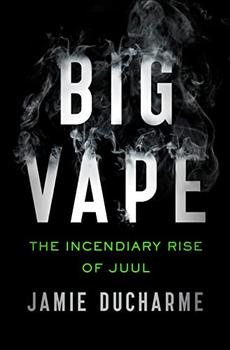Summary | Excerpt | Reviews | Beyond the Book | Readalikes | Genres & Themes | Author Bio

The Incendiary Rise of Juul
by Jamie Ducharme
The archive laid out everything—from the way cigarettes were designed and manufactured to how they were sold by advertising executives—and it was all right there, in tobacco executives' own words. Adam and James could study the minutiae of cigarette chemistry to understand what made the product so appealing. Without ever holding a focus group, they could analyze market research about consumer preferences and tastes. They could sift through internal memos to learn how tobacco companies had sold their products to just about any and every demographic—including, as they admitted, teenagers. For two graduate students trying to turn a bright idea into a blockbuster product, the archive was a gold mine. Sure, the documents were full of red flags, ethical dilemmas, and flagrant abuses of public trust—but the information! It was too good to resist. "We had so much information that you wouldn't normally be able to get in most industries," James would say later. "And we were able to catch up, right, to a huge, huge industry in no time. And then we started building prototypes."
They had a good amount of catching up to do: in the race for a "safer" cigarette, they were learning, the tobacco industry had had a sizable head start. Industry executives had been talking out of both sides of their mouths for decades, claiming that smoking was harmless at the same time that they were surreptitiously looking for safer alternatives to it. By the early 1960s, tobacco executives knew that cigarettes caused cancer and other diseases, but they chose to shield their loyal customers from that information. The scientific community had no such reservations. Studies suggesting links between smoking and cancer, respiratory illnesses, and heart disease had been piling up and generating news coverage for some time, and the smoking public was starting to get uneasy. (Their unease was kicked into overdrive in 1964, when the surgeon general released a report that explicitly warned Americans about the dangers of smoking, including cancer.) Tobacco companies introduced filtered cigarettes to calm the masses, pitching them as a "lighter" way to smoke—even though internal testing showed they did little to block the inhalation of cancer-causing toxins.
In the early 1960s, researchers at British American Tobacco (BAT), led by a man named Sir Charles Ellis, thought of a way they could go even further. Ellis's whole idea hinged on avoiding a process called combustion. Combustion happens when a cigarette is lit on fire and the tobacco mixes with the oxygen in the air, producing smoke, ash, and roughly seven thousand chemical by-products, some of which can lead to cancer. If BAT could develop a product that delivered nicotine without all the chemicals and by-products that made people sick, Ellis thought, it could keep many smokers from quitting. Nicotine, he reasoned, was relatively harmless on its own. Yes, it was a mild stimulant, and yes, it was addictive, but it had some benefits, too—like increasing concentration and focus while simultaneously soothing the nerves. Why not get smokers hooked on that alone, instead of on traditional cigarettes? Ellis's project was known internally as "Ariel."
Ellis's team had its first breakthrough in 1962, with a cigarette-within-a-cigarette design. An inner tube of nicotine extract and water was wrapped in a thin layer of aluminum, which separated it from an outer layer of tobacco that smokers would light on fire. As it burned, the outer layer would warm the inner one, and as the internal nicotine extract heated up, it would produce an aerosol that users could inhale. Each puff would bring a burst of nicotine, without all the tar and other nasty by-products in cigarettes. Ellis's fundamental design worked, but it took years of tinkering to get the nicotine extract right. BAT's team worked with what's known as freebase nicotine, a form of nicotine that is quite harsh to consume. It took lots of trial and error for BAT's researchers to figure out that mixing freebase nicotine with an acid could mellow it out and make it much easier to inhale.
Excerpted from Big Vape by Jamie Ducharme. Copyright © 2021 by Jamie Ducharme. Excerpted by permission of Henry Holt and Company. All rights reserved. No part of this excerpt may be reproduced or reprinted without permission in writing from the publisher.
Your guide toexceptional books
BookBrowse seeks out and recommends the best in contemporary fiction and nonfiction—books that not only engage and entertain but also deepen our understanding of ourselves and the world around us.